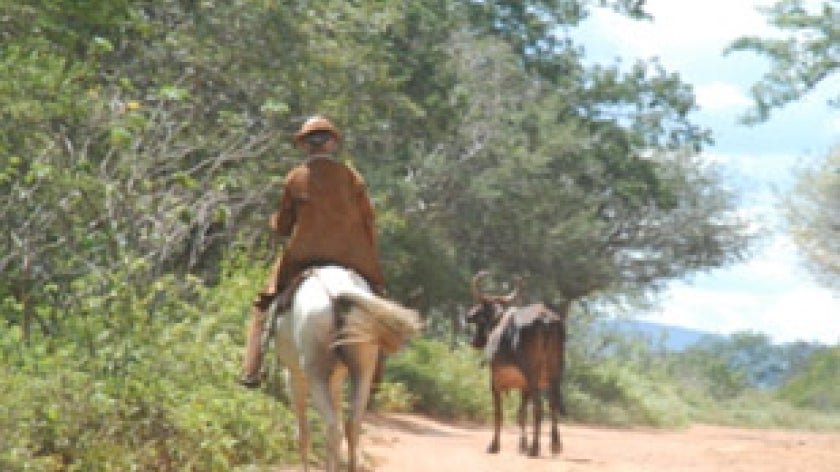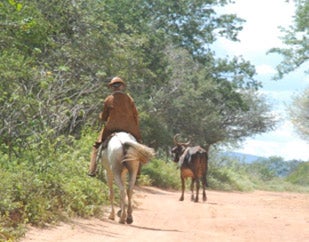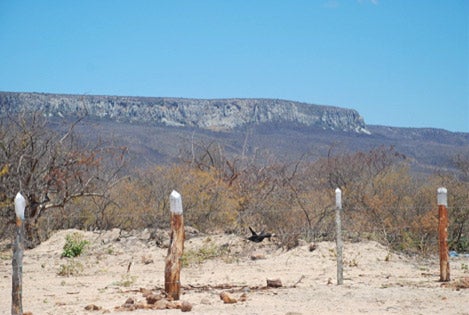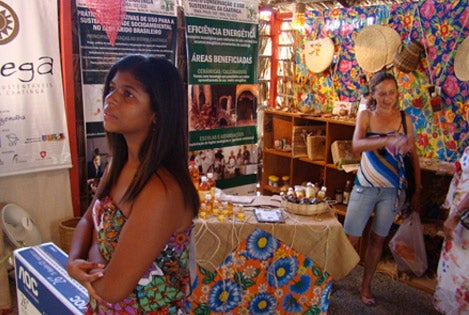

Demonstrations of Integrated Ecosystem and Watershed Management in the Caatinga
The unique Caatinga Biome is located in the semi-arid region of Brazil, which has a hot and dry climate with recurrent droughts. This tropical dry forest is characterized by xerophytic and deciduous low to medium sized trees, thorny bushes, and some taller trees that reach 20 meters. Five broad types of Caatinga form a complex mosaic of vegetation that constitutes a world center for biodiversity with high species diversity and endemism. Importantly, the Caatinga has global significance as a potential carbon store, with standing woody biomass averaging 44 m3 per hectare (ha), and an annual increment ranging from 1.5 to 6 m3 per ha, representing a carbon sink of at least 4.5 billion tCO2 considering only above-ground biomass.
De

Given its vulnerability and low Human Development Indexes, this region was made a high priority for development programs by the Government of Brazil. However, the long-term sustainability of development in the Caatinga can only be achieved if the vulnerable, highly dynamic and inter-related characteristics of the ecoregion form a pivotal role in planning and implementing development actions. Such holistic actions had been limited by many barriers, including systematic, institutional and financial capacity.

To address those barriers, UNDP and GEF partnered with the Government of Brazil to implement the project "Demonstrations of Integrated Ecosystem and Watershed Management in the Caatinga," which had two complementary approaches: (1) implementation of site-specific demonstrations in integrated ecosystem management (IEM) at the state level to define "best-bet" land-use practices that conserve ecosystem integrity under different socio-economic scenarios ; and (2) delivery of cross-cutting capacity building to ensure multi-sectoral capacities are available to enhance the adoption of the demonstration throughout the biome with best-bet practices being replicated at locations that display similar scenarios. The anticipated global benefits included the avoidance of carbon emissions and an increase in carbon capture—the former via the reduction of deforestation rates and the latter through reforestation of degraded lands.
Overall, the project delivered impressive results in line with its objective. It was particularly successful in demonstrating sustainable forest management (SFM) in different types of Caatinga forest—showing landowners the potential for and benefits of alternatives to clearing the forest for agriculture. The project also supported the uptake of these SFM practices by developing management plans for landowners interested in adopting the demonstrated methods and practices. Through this work, the project delivered benefits to some of the poorest people in Brazil while also generating global environmental benefits.
In tandem with its on-the-ground efforts, and to improve the institutional capacity for IEM, the project worked with Caatinga State Governments and the federal Government by providing advice and technical inputs. The project enabled the inclusion of its best practices in Government actions and programs. The project also supported the decentralization of the Forestry Management Programme by performing a socio-economic and environmental assessment, and creating SFM proposals for five Northeast states. Additionally, with project support, the Ministry of Environment incorporated the forest management model into public policies, while multiple-use SFM practices in agrarian reform settlements now form part of the National Forestry Program policy for Caatinga Biome; these important policy changes make the sustainability of the project's impacts likely.
The project was designed as the first part of a three-phase programme. As such, it was intended to serve as the foundation for a paradigm shift in the way land is used in the Caatinga. To set the stage for future interventions, the project verified the global environmental benefits that SFM can provide in the Caatinga; building on data collected in Caatinga over the last 25 years with support of UNDP and FAO, the project conducted a first ever analysis on the second generation of cutting. The study showed that Caatinga species have a high regeneration rate (> 90 percent) and that in secondary re-growth flora and fauna levels recover to compositions similar to those prior to cutting and are comparable with those in protected areas. It also showed that the soil of forests under management maintains its ability to absorb water and process nutrient flow, which are vital ecosystem services.
The project also supported a study on forest cover and carbon fixation in the Caatinga. The results of this study showed that: the annual gross emissions arising from the industrial consumption of firewood and charcoal in the Northeast (16.6 million tCO2 in 2000) are modest compared with the Caatinga's annual potential to absorb CO2 (256.2 million tCO2); the savanna has an important, yet underutilized, potential for absorbing atmospheric carbon and for the production of biomass fuels; and the carbon stock of woody biomass in the region is very high, indicating that land use changes that lead to deforestation are likely to release large amounts of CO2 and other GHGs. These results speak to the importance of SFM and IEM in the region.

By its end, the project had successfully provided rural inhabitants and industries with integrated ecosystem management options for different social-environmental scenarios in the Caatinga Biome, and strengthened capacity for IEM. The area of Caatinga forest under sustainable management increased by 368,251 ha across six sites and 20 rural settlements. The project reduced the percentage of industries that use Caatinga firewood, advanced the adoption of energy efficiency techniques, supported the creation of new protected areas that cover over 5.7 million ha, and involved families in sustainable eco-business plans—thereby setting the stage for securing the forests of the Caatinga Biome and the carbon they store.
Project Summary
GEF Project ID Number: 1343
Duration: 6 years (February 2004 – December 2010)
GEF Grant: US$4.1 million
Co-financing: US$22.3 million (committed); US$27.3 million (leveraged resources)
Contact Person: Helen Negret, UNDP Region-based Technical Adviser, Ecosystems and Biodiversity (helen.negret@undp.org)
As part of the GEF's support to the International Year of Forest, every month we are publishing a story about a successful GEF project that is promoting sustainable forest management, and having positive impacts on forests, climate, biodiversity and local livelihoods.